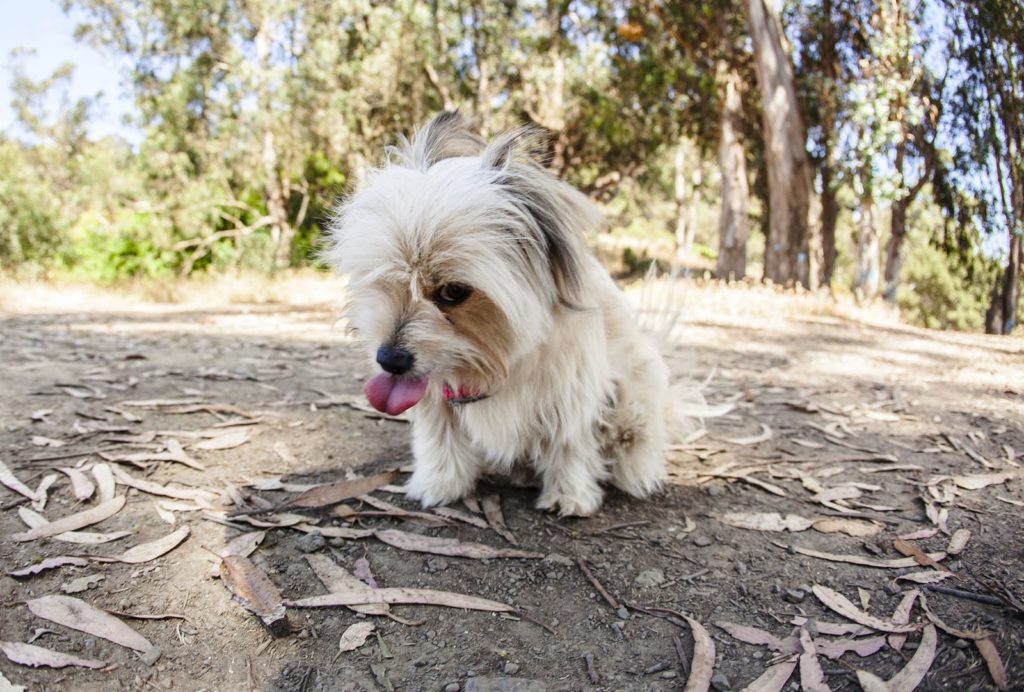
by Lauren Ford on August 29, 2019
Did you know that our dogs are trying to talk to us all the time? Norwegian dog trainer and behaviorist Turid Rugaas, in her groundbreaking book, On Talking Terms With Dogs explained dog behaviors as deliberate communications. She coined the phrase “calming signals” to describe the body language that dogs use to avoid conflict, invite play, and negotiate the use of their space with other dogs – and also humans!
Here are 5 calming signals that you can easily learn to recognize and even use yourself to interact with your dog friends and build deeper and more meaningful relationships.
1. Head turning/Look Away Your dog may use head turning to tell you or an approaching dog to calm down. Perhaps the other dog approached yours too quickly, or approached her head on instead of in a curve. If the look away is also accompanied by a happy, open-mouthed, relaxed face it could also be communicating “I am no threat” and an invitation to play. You can use head turning yourself when a dog seems worried if you have approached her suddenly. If a scared dog starts to bark or growl at you, stop moving towards her, turn your head to one side and this will help her feel better./
2. Softening the Eyes/ Blinking Many dogs find it difficult to have direct facial contact, and staring eyes are generally seen as threatening. Blinking and/or softening the eyes is an intentional communication: “See, my eye contact is friendly.” This is one I use often with Tuna when we’re on an airplane and she looks up at me with a nervous “What’s going on?” kind of expression. I blink a lot and look at her through soft eyes. She returns the blinks to me, and seems to visibly relax.
3. Lip licking/Smacking/Tongue Flick You may notice your dog use a quick movement of the tongue when approaching another dog. If you bend over your dog or hold him tight, or if you bend down to grab him or talk to him in an angry voice, he may use this signal. You could try using a lip smacking sound or flick of the tongue to acknowledge your dog’s signal and to calm him down, or even just to get his attention in a non-threatening way.
4. Sitting or Lying Down Your dog might sit down if another dog is making her feel uncertain or if you yell to make her come. She might lie down if play gets too rough or she gets tired during play, or if another dog seems afraid of her. Try sitting when your dog is stressed. If your dog seems scared of you, not daring to come closer, try lying on the sofa. In many cases she’ll be there within a few seconds.
5. Yawning Dogs yawn when they are slightly stressed by something in the environment. It is both a stress signal, as in: “ You are getting closer,” and a negotiation signal, as in: “I am allowing you in at this moment.” You can use it when your dog feels uncertain, a little bit scared, stressed, worried, or when you want him to calm down a bit.
To learn more about the 30-plus signals that dogs use to communicate with each other, I recommend reading On Talking Terms With Dogs by Turid Rugaas and Canine Body Language by Brenda Aloff. All of the research on canine learning and behavior suggest strongly that there is absolutely no reason to punish, be violent, threatening, or forceful towards a dog. This will only make the dog more stressed, in time sick, and eventually aggressive. Try to find the reasons why your dog is stressed, make sure they’re getting enough exercise, and when in doubt, seek help from an experienced positive reinforcement trainer.
